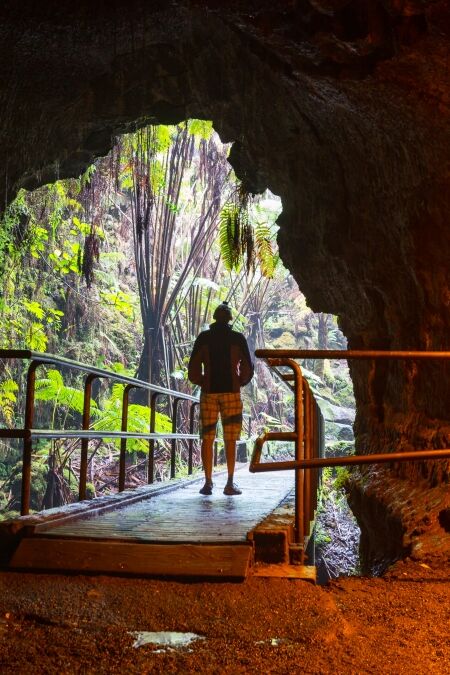On the eastern side of the Big Island of Hawaii near Pahoa, Lava Tree State Monument is a captivating geological and botanical park that offers a glimpse into Hawaii’s volcanic past. This unique park features the fascinating lava molds of tree trunks, created by a volcanic eruption in 1790, making it a must-visit destination for both nature lovers and geology enthusiasts. This article aims to provide a comprehensive guide to exploring Lava Tree State Monument, ensuring visitors can fully appreciate its natural beauty and historical significance.
Highlights
- Witness the fascinating natural sculptures created by fast-moving lava that engulfed tree trunks, leaving behind hollow molds in their place.
- Enjoy an easy and scenic walk along the 0.7-mile loop trail that takes you through the park’s lush vegetation and stunning lava formations.
- Take advantage of the park’s picnic areas for a relaxing meal amidst the serene natural surroundings.
- The park’s unique landscape offers plenty of opportunities for striking nature photography.
History

The Fiery Birth of Lava Tree State Monument
The Lava Tree State Monument tells a story of volcanic fury and the resilience of nature. It all began in 1790, when a dramatic eruption of the Kilauea volcano sent lava flows surging down the slopes, engulfing everything in their path.
Nature's Sculptures in Stone
Among the casualties of the flow were the native ʻōhiʻa trees that populated the area. As the lava flowed around them, it cooled and hardened, encasing the tree trunks in a natural mold. These unique formations offer a rare glimpse into the island’s volcanic past.
The Unveiling of Lava Ghosts
When the lava flow receded, it left behind hollow, vertical lava shells – the ghosts of the once-living trees. These natural sculptures stand as a testament to the power of volcanic forces and are a highlight for visitors exploring the park.
A Monument to Preservation
Recognizing the significance of these lava trees, residents advocated for their protection. The area was eventually designated as a State Monument, likely sometime in the 20th century, to preserve this unique geological wonder for future generations.
Historical Gaps
Unfortunately, specific details about the monument’s establishment, such as the exact year it became a State Monument, are not readily available in official sources. However, its importance as a natural wonder is undisputed.
A Living History
Today, the Lava Tree State Monument continues to attract visitors eager to witness the raw power of nature and the fascinating ways landscapes can be transformed by volcanic activity. The park’s tranquil atmosphere and striking scenery make it a must-visit destination. With its peaceful environment and off-the-beaten-path location, Lava Tree State Monument offers a serene escape from the crowds. It’s an ideal spot for those seeking tranquility and a deeper connection with nature.
Highlights and Attractions
Lava Trees
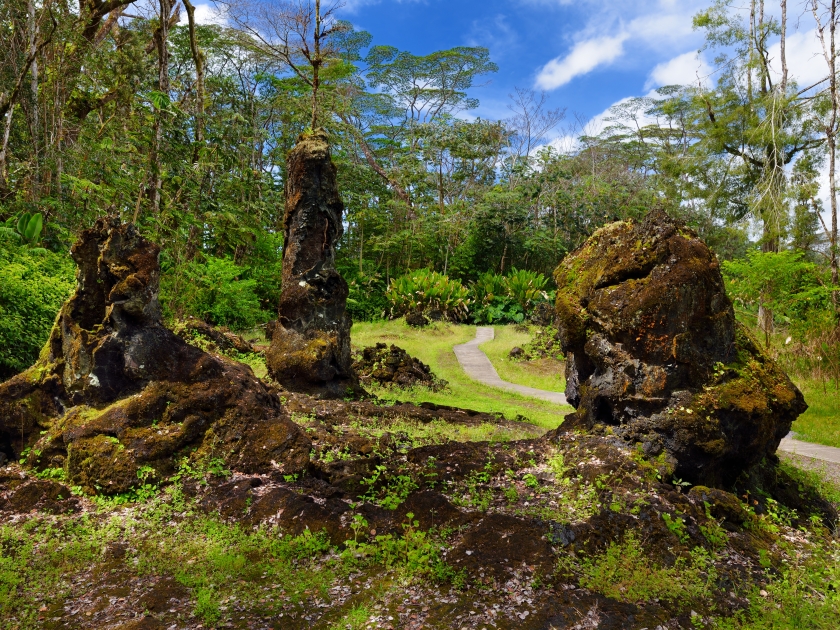
The main attraction at Lava Tree State Monument is the remarkable collection of petrified tree molds, formed by lava flows that enveloped the trees during the 1790 eruption. These natural sculptures, standing like sentinels, offer a unique window into the island’s volcanic history, showcasing the powerful interaction between molten lava and lush forest.
Walking Trails
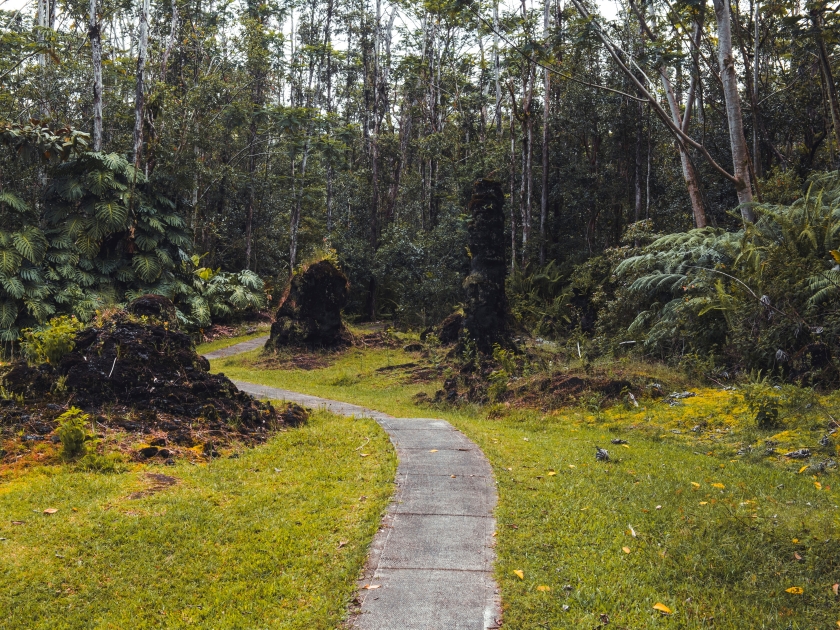
The park features a 0.7-mile loop trail that meanders through the captivating landscape, allowing visitors to explore the lava trees up close. Along the path, interpretive signs provide insights into the geological and botanical features of the area, making it an educational and scenic walk.
Flora and Fauna
Lava Tree State Monument is home to a diverse array of plant and animal life, thriving amidst the volcanic terrain. Visitors can observe native Hawaiian plants, such as ohia trees and hapu’u ferns, as well as various bird species that inhabit the park. The juxtaposition of verdant greenery against the stark lava formations creates a striking and serene environment.
Activities and Experiences
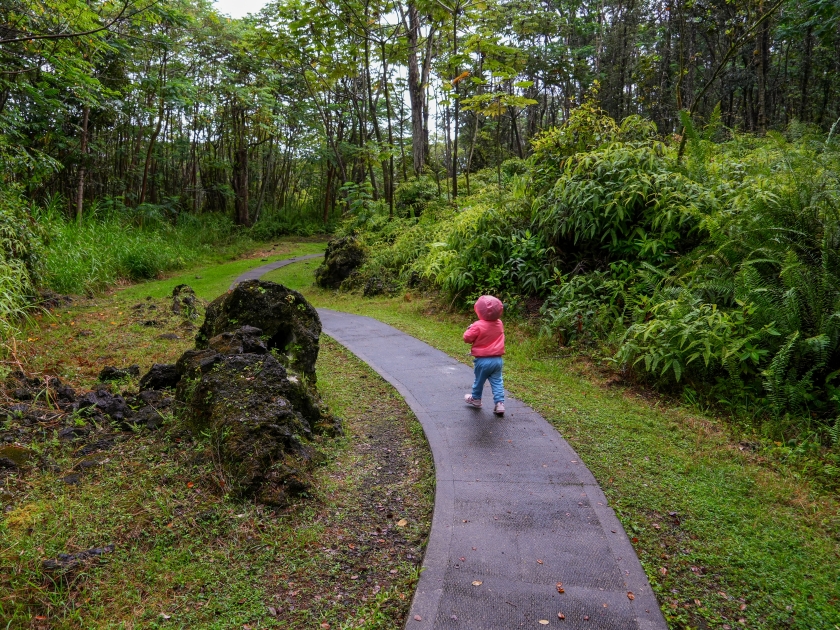
Hiking Adventures
Lava Tree State Monument offers excellent hiking opportunities, with its primary 0.7-mile loop trail providing a leisurely yet informative stroll through the park. To make the most of your hike, wear sturdy shoes, bring plenty of water, and take your time to read the interpretive signs that offer fascinating details about the area’s geological and botanical features.
Photography Hotspots
The park is a photographer’s paradise, with numerous spots perfect for capturing the unique beauty of the petrified tree molds and lush surroundings. The early morning or late afternoon light offers the best conditions for stunning shots, highlighting the contrast between the dark lava formations and vibrant greenery.
Educational Programs
For those seeking a deeper understanding of Lava Tree State Monument, guided tours and educational programs are occasionally available. These programs provide valuable insights into the park’s history, geology, and ecology, enhancing the visitor experience through expert knowledge and engaging storytelling.
Tips for Visiting
- Stay hydrated by carrying sufficient water, especially on hot days.
- Wear comfortable, sturdy shoes suitable for walking on uneven terrain.
- Bring a hat, sunscreen, and sunglasses to protect yourself from the sun.
- Pack light snacks to keep your energy up during your visit.
- Check the weather forecast before your visit and be prepared for sudden rain showers.
- Stick to designated paths to protect the delicate ecosystem and avoid getting lost.
- Use insect repellent to guard against mosquitoes and other insects.
- Visit during the cooler parts of the day for a more comfortable experience.
- If possible, plan your visit on a weekday to avoid the weekend crowds and have a more peaceful experience.
- Bring a camera or smartphone to capture the unique landscape and natural beauty.
- Pack out all trash and leave no trace to help keep the park clean and pristine.
- Observe wildlife from a distance and do not feed or disturb the animals.
Best Times to Visit
The best times to visit Lava Tree State Monument are during the early morning or late afternoon when the temperatures are cooler, and the lighting is perfect for photography. Weekdays are ideal for a more tranquil experience, as weekends tend to draw larger crowds. Visiting during these times not only enhances your comfort but also allows you to fully appreciate the serene beauty and unique geological features of the park.
Nearby Attractions
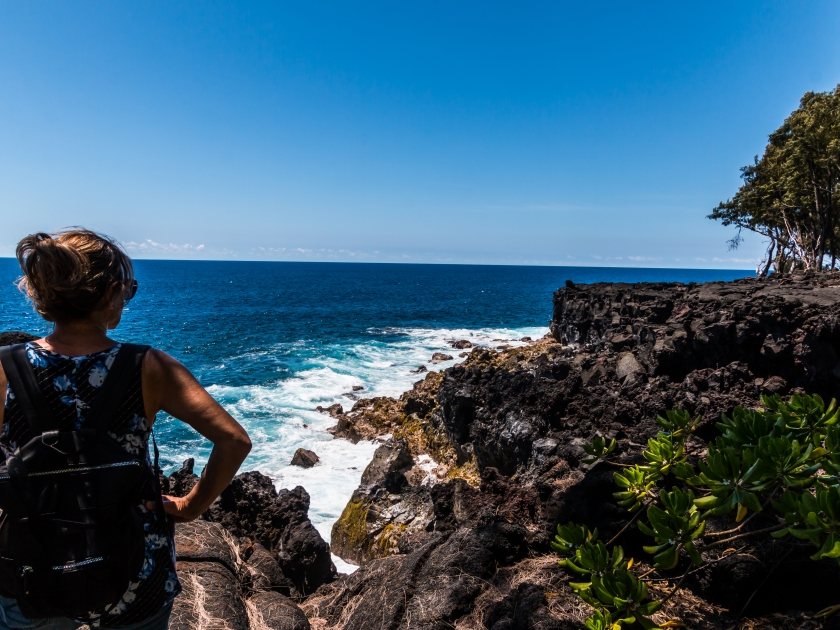
When visiting Lava Tree State Monument, be sure to explore nearby natural attractions to enrich your experience. Just a short drive away, MacKenzie State Recreation Area offers stunning coastal views and rugged landscapes perfect for picnicking and hiking. Additionally, Pahoa Village provides a charming glimpse into local culture with its eclectic shops, cafes, and historic buildings. Together, these nearby destinations offer a well-rounded exploration of the Big Island’s diverse scenery and vibrant communities.
Local Dining and Accommodations
For a delightful dining and lodging experience near Lava Tree State Monument, consider stopping by Pele’s Kitchen for a hearty breakfast featuring locally sourced ingredients, or enjoy a casual meal at Black Rock Cafe, known for its comfort food and friendly atmosphere. For accommodations, Pahoa Village Hostel offers a budget-friendly option with a cozy, communal vibe, while the Hawaiian Sanctuary Retreat Center provides a more immersive experience with its eco-friendly lodgings and wellness programs. These options ensure a comfortable and enjoyable stay, adding to the charm of your visit to the area.
Frequently Asked Questions (FAQs)
Lava Tree State Monument is a park in Hawaii that features unique lava molds of tree trunks formed by a lava flow in 1790.
Visitors can see fascinating lava tree molds, lush tropical vegetation, and scenic walking trails at Lava Tree State Monument.
Yes, Lava Tree State Monument is child-friendly with easy walking trails and educational displays about the lava formations.
Lava Tree State Monument is open daily from sunrise to sunset, with no entrance fee.
Yes, Lava Tree State Monument has picnic tables, restrooms, and parking available for visitors.
A visit to Lava Tree State Monument typically takes about 1-2 hours, allowing time to explore the trails and enjoy the scenery.
How to Get There
By Car
Driving to Lava Tree State Monument provides a convenient and flexible option, allowing you to explore the beautiful landscapes at your own pace. Begin your journey in Hilo, and take Highway 130 (Keaau-Pahoa Road) heading southeast. Continue on this road for approximately 18 miles until you reach the town of Pahoa. From there, take a left onto Highway 132 (Kapoho Road) and drive for about 3 miles. The entrance to the park will be on your right, clearly marked with signs. The entire trip offers scenic views that set the tone for the natural wonders awaiting you at the monument.
By Bus
Traveling to Lava Tree State Monument by bus is a more eco-friendly and communal option. If you’re starting from Hilo, you can take the Hele-On Bus route 10 from Hilo to Pahoa. Services run several times a day, but it’s essential to check the latest schedule as times may vary. Upon reaching Pahoa, you will need to transfer to another bus or arrange for a taxi or ride-sharing service for the last leg of the journey to the state monument. Though it requires a bit more planning and patience, the bus ride allows you a hands-free journey to soak in the surroundings without the stress of driving.
Embrace the Timeless Beauty
Lava Tree State Monument stands as a testament to the powerful forces of nature, offering visitors a unique glimpse into Hawaii’s volcanic past amidst a lush, serene landscape. This extraordinary destination is a must-visit for anyone seeking to explore the island’s natural wonders and geological history. We invite you to add Lava Tree State Monument to your travel itinerary and immerse yourself in its captivating beauty.



